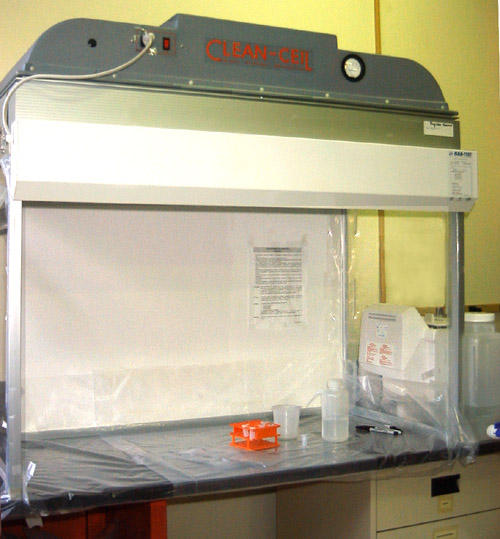Otolith Decontamination for Elemental or Isotopic Analysis
The basic handling of otoliths intended for elemental or isotopic assay is to clean, then protect from potential contaminants. A simplified protocol is as follows:
- Remove sagittal otolith pair from fish immediately after capture; alternatively, freeze fish, but do not store in liquid preservative.
- Upon otolith removal, immediately remove all adhering tissue. Handling with metal forceps or fingers at this stage is acceptable.
- Decontaminate otolith by sonifying in a series of distilled, deionized, reverse osmosis water baths (Super Q or Milli Q water) in acid-washed polyethylene vials. Brushing with an acid-washed nylon toothbrush under a flow of Super Q water can be used to remove any adherent tissue before the first sonification. All handling at this and subsequent stages must be with non-metallic, acid-washed tools (except for radiocarbon assays).
- Dry decontaminated otoliths in a positive flow laminar flow fume hood (Class 100); store in dry, acid-washed polyethylene vials. Storage in aluminum foil is appropriate for samples to be assayed for radiocarbon. However, vials are easier to use, and less likely to result in loss of small pieces when opened.
We have prepared a 10-minute VIDEO DEMONSTRATION of decontamination techniques for otolith material. The information below also describes decontamination, but provides more detail on some of the materials and suppliers than does the video.
A detailed protocol for each of the decontamination steps is shown below:
Preparation of Plastic Equipment
All new plastic equipment (vials, caps, forceps, etc.) is rinsed in 95% ethanol then in SuperQ water, air-dried in a positive pressure chamber (Clean Cell) and repackaged in plastic bags prior to being acid washed.
Acid washing operations are performed in a fume hood and all equipment is handled by an operator wearing acid-resistant rubber gloves and using Teflon tongs. The acid bath is made of cross-linked high-density polyethylene (XLPE) kept covered before and during immersion. Water baths are either made of XLPE or high density polyethylene (HDPE).
The plastic equipment to be decontaminated is immersed for at least 8 hours in 6N HCl trace metal grade, rinsed 3 times in SuperQ, immersed for 4 hours (rest-rinse) in SuperQ, triple-rinsed in SuperQ and stored in sealed plastic bags. After this operation, the acid washed equipment is taken to a Clean Cell to be air-dried then repackaged in sealed plastic bags prior to being used.
Warning: Hydrochloric acid 12N is diluted 1:1 with SuperQ to obtain the required 6N. The acid is added to the water. This operation is performed in a fume hood.
Otolith Decontamination and Handling
During decontamination, otoliths are handled by an operator wearing plastic gloves. Otoliths are in contact with ultra-clean chemicals and equipment/instruments made of Teflon, polyethylene and polypropylene only. Each otolith is placed in a labeled 50 ml acid-washed conical vial, covered with SuperQ water, and sonified for 5 minutes in an ultrasonic cleaner. Vials are placed in groups of 5 attached with an elastic band and sonified at the same time. After the first sonification, each otolith is scrubbed using an acid-washed toothbrush under running SuperQ (1 minute) to remove particles and/or membranes from its surface. Each otolith is then triple-rinsed with SuperQ and placed back in its acid-washed vial with fresh SuperQ. Each otolith is sonified for 3 minutes (vials in groups of 5 again) then triple-rinsed with SuperQ. Finally, the otoliths are air-dried in their vial cap inside the Clean Cell for 18-24 hours and later stored inside their respective vials tightly closed. Note that the 50 ml conical vials can be re-used for decontaminating the next set of otoliths (max 5 times), if they are not going to be used for digestion.
Vials containing the otoliths are taken to the balance for weighing one at a time. Minimizing time outside the vial and exposure to ambient air, each otolith is quickly transferred to an acid-washed vial cap kept inside the balance (tared before weighing). During this operation, the vial is kept closed. As always, the otoliths are handled with plastic forceps/plastic gloves.
If otoliths are to be digested in their 50-ml conical vial, they can be stored dry in those vials until then. Otherwise, they can each be stored in a labeled 2.5 ml acid-washed plastic vial (5 ml for bigger otoliths), tightly closed. All vials are placed in peg trays covered with a sheet of plastic inside the Clean Cell, or sealed within an acid-washed plastic bag.
In terms of vials which can be used for both otolith decontamination and acid digestion, we use 50-ml polypropylene conical vials from Fisher Scientific (part number 05-539-6). For acid washing, we buy trace metal grade 12N HCl and dilute to 50% in Super Q water. The initial ethanol soak of new vials (before acid washing) is done in 95% non-denatured ethanol. Gloves for handling otoliths and vials are disposable polyethylene from Fisher (part 11-394-100A). You do NOT need to acid wash these gloves before using. Surgical gloves often have a powder in them to make them more comfortable, but this powder can contaminate your assays, so should not be used.
The Clean-Cell is a vertical laminar flow work station, rated to Class 10 or 100. You'll probably want to buy a roll of 3 mil polyethylene sheeting or bags to line the Clean Cell floor with, which can be replaced periodically. Of course, the sheeting should be wiped down with ethanol after being put in the Clean Cell and before use.
Decontamination in preparation for bomb radiocarbon assay is similar, but somewhat less stringent, than that used for elemental assay. The cleaning and sonification steps are the same as described above. However, acid-washed plastics are not required (although they must be clean and free of all organic debris). Also, metallic instruments do not contaminate radiocarbon.
